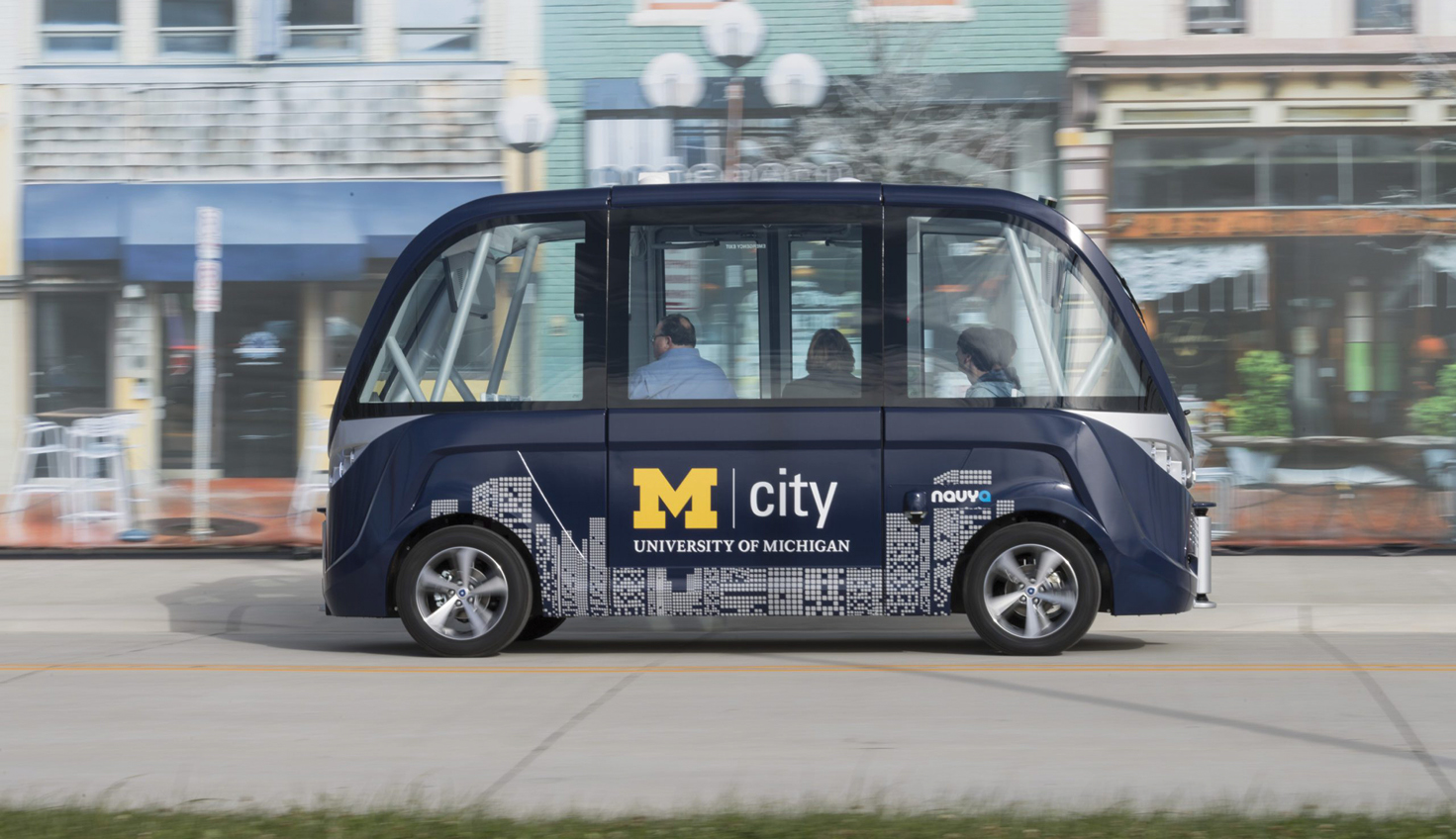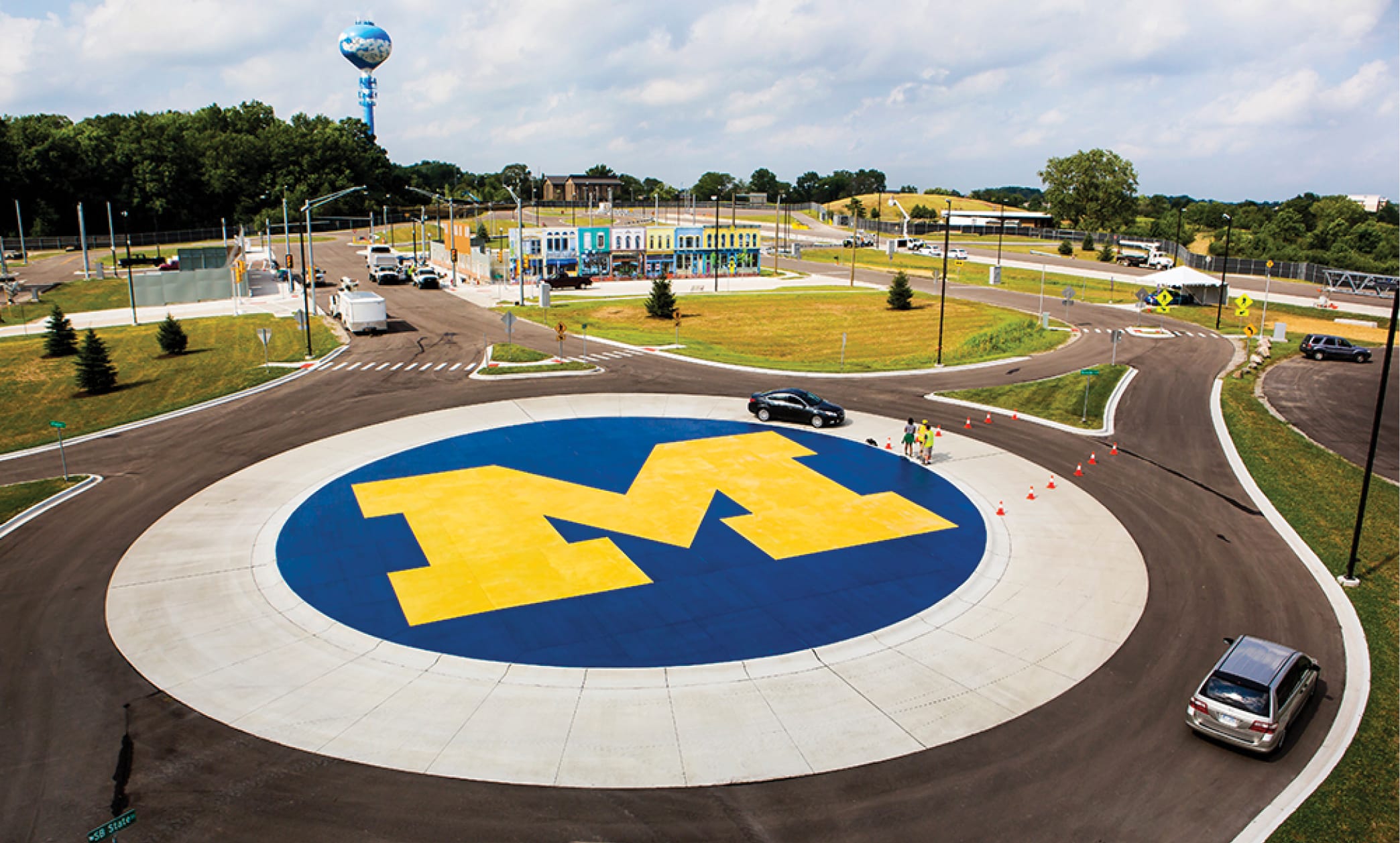American Center for Mobility
Ypsilanti
ACM is situated on the Willow Run site in Ypsilanti, covering an area of over 500 acres in Southeast Michigan. It provides several services, including an Advanced Mobility Proving Ground with specialized infrastructure, equipment, facilities and resources for testing purposes. There is also an innovation and technology campus that incorporates an industrial tech park for mobility companies to co-locate. Additionally, the facility offers event and demonstration areas that allow the showcasing of mobility technologies and the convening of industry activities.
MCity
Ann Arbor
Mcity is a public-private partnership between the University of Michigan’s Mobility Transformation Center (MTC), the Michigan Department of Transportation (MDOT), and numerous industry partners. It is a 32-acre simulated urban and suburban environment, located on the University of Michigan’s North Campus in Ann Arbor. The facility is designed to provide a safe, controlled, and realistic environment for the testing of connected and automated vehicles (CAVs) and mobility technologies. Mcity’s infrastructure includes roads with various complexities, intersections, traffic signs, signals, and buildings. It also has a range of features such as simulated pedestrians, bicycles, and obstacles to enable researchers to study how CAVs interact with the surrounding environment.
University Research Corridor
Lansing
Michigan’s University Research Corridor (URC) is a partnership between three leading research universities in Michigan: the University of Michigan (U-M), Michigan State University (MSU), and Wayne State University (WSU). The URC was established in 2006 to leverage the collective expertise, talent, and resources of the three institutions and promote economic growth in the state of Michigan.
The URC is one of the nation’s top academic research clusters, and it ranks among the top research corridors in the world. The three universities in the URC collectively conduct over $2.6 billion in annual research, making it one of the largest research clusters in the United States. The URC focuses on research in a wide range of areas, including healthcare, energy, mobility, advanced manufacturing, and more. It also works to foster innovation, entrepreneurship, and collaboration between academia, industry, and government to drive economic development in Michigan and beyond.

The Autonom, a driverless electric shuttle manufactured by French firm NAVYA, was introduced to North America at the Mcity Test Facility in December 2016. NAVYA is an affiliate member of Mcity.
Courtesy of Mcity
LIFT
Detroit
The American Lightweight Materials Manufacturing Innovation Institute (ALMMII) runs LIFT, which is a collaboration between the U.S. Department of Defense, industry and academia. As one of the national network of manufacturing innovation institutes, LIFT is playing a vital role in propelling the U.S. mobility sector toward the upcoming manufacturing revolution. By doing so, it aims to strengthen the country’s economy and improve its national security.
UM Battery Lab
Ann Arbor
The UM Battery Lab is a research core situated on the campus, which provides academic and industrial users from all over the world with the necessary expertise and resources to prototype, test and analyze batteries and their constituent materials. The lab’s goal is to collaborate with the academic and industrial energy storage community by bringing together scientists, engineers, suppliers and manufacturers to overcome a bottleneck in battery development near the country’s automotive capital. The facility is open to any company or researcher, and it serves as a secure space for IP-protected discovery, scaling up and testing of advanced batteries and battery materials.
Selfridge Air National Guard Base
Harrison Township
Selfridge Air National Guard Base is an Air National Guard installation named after Thomas Selfridge, a military aviation pioneer who was the first person to die in an airplane crash while on a powered flight with Orville Wright.
The base houses the Michigan Air National Guard’s 127th Wing, which includes an F-16 fighter squadron, an aerial refueling squadron, and a maintenance group. It is also home to a number of other military units, including the U.S. Coast Guard, U.S. Customs and Border Protection, and the Michigan Army National Guard.
Selfridge Air Base serves as a training and deployment site for military personnel from around the country, as well as a center for research and development in the field of aerospace technology. The base is also a major economic driver in the region, providing jobs and opportunities for local businesses.
Camp Grayling
Grayling
Camp Grayling is a military training center and is the largest National Guard training facility in the country, covering an area of over 147,000 acres. The camp is used for military training by the Michigan National Guard, other branches of the U.S. military and military units from other countries. It offers a wide range of training facilities, including live-fire ranges, maneuver areas and urban training centers, as well as air and artillery ranges.
Camp Grayling also serves as a venue for joint military exercises involving various branches of the military, government agencies and international partners. The camp plays an important role in maintaining military readiness and supporting national security, while also contributing to the local economy through job creation and economic activity.
Detroit Arsenal & TARDEC
Warren
The Detroit Arsenal is a U.S. Army facility located that serves as a major center for research, development and production of military equipment and technology, with a focus on ground combat systems.
The arsenal is home to the U.S. Army Tank Automotive Research, Development and Engineering Center (TARDEC), which is responsible for developing advanced technologies for ground vehicles, such as the development of the autonomous vehicle technology for military purposes. It also houses the Program Executive Office Combat Support & Combat Service Support (PEO CS&CSS), which is responsible for the acquisition and sustainment of ground combat support and combat service support systems.
The Detroit Arsenal plays a vital role in supporting the U.S. military’s ground forces, providing equipment, technology, and support for soldiers around the world. It is also a significant contributor to the local economy, providing jobs and generating business for the surrounding area.
Michigan Life Sciences and Innovation Center
Plymouth
The Michigan Life Science and Innovation Center (MLSIC) is a research facility located in Plymouth that focuses on the development and commercialization of life sciences technologies. The center provides laboratory and office space, as well as access to specialized equipment and technical support, to early-stage life sciences companies, academic researchers and other entrepreneurs. It offers a range of resources and services to support the development and commercialization of life sciences technologies, including access to state-of-the-art laboratory equipment, specialized training programs and mentorship from experienced entrepreneurs and industry experts.
The MLSIC is a joint project of the Michigan Economic Development Corporation (MEDC) and the Michigan State University Foundation. It is part of a larger network of innovation and entrepreneurship centers in Michigan, aimed at fostering the growth of high-tech industries in the state. The center is strategically located near major research institutions and pharmaceutical and biotech companies, providing ample opportunities for collaboration and networking. The MLSIC has helped to launch several successful life sciences companies, and it continues to be a key resource for entrepreneurs and researchers in Michigan’s growing life sciences industry.
Great Lakes Environmental Research Laboratory
Ann Arbor
The Great Lakes Environmental Research Laboratory (GLERL) is a research center within the National Oceanic and Atmospheric Administration (NOAA) that conducts scientific research and provides environmental information and services to support the management and protection of the Great Lakes ecosystem. GLERL’s research focuses on a range of topics, including ecosystem dynamics, harmful algal blooms, climate change, water quality and coastal hazards. The center uses advanced technologies and models to monitor and study the Great Lakes, and its work provides critical information to policymakers, resource managers and the public to support the sustainable management and conservation of the Great Lakes ecosystem.
Keewenaw Research Center
Hancock
The Keweenaw Research Center (KRC), part of Michigan Technological University, is located in Michigan’s remote Upper Peninsula. The KRC conducts research on a range of topics related to vehicle testing and evaluation, including durability testing, fuel efficiency and cold weather performance. The center is equipped with specialized facilities and equipment for testing vehicles in extreme conditions, and its work supports the development of more efficient and reliable vehicles.
